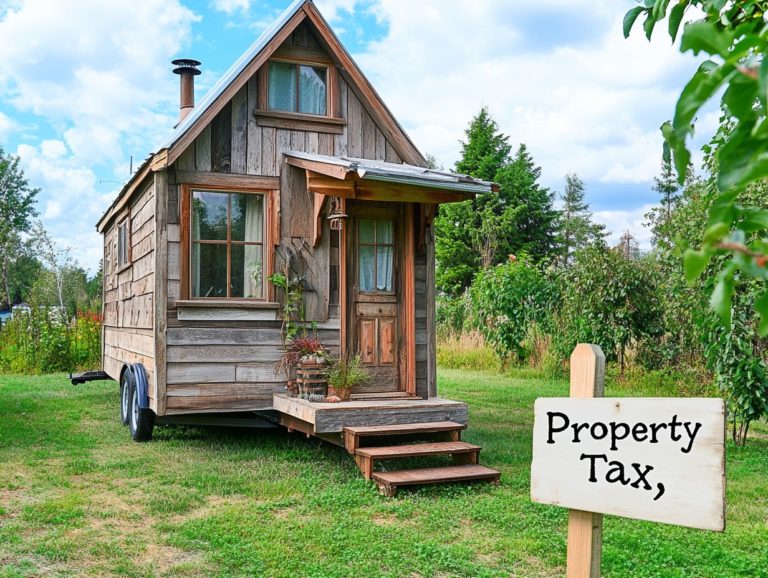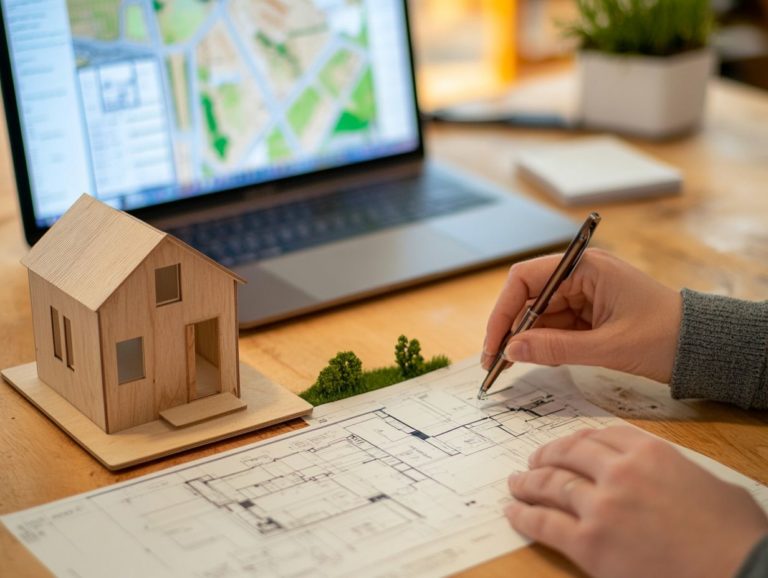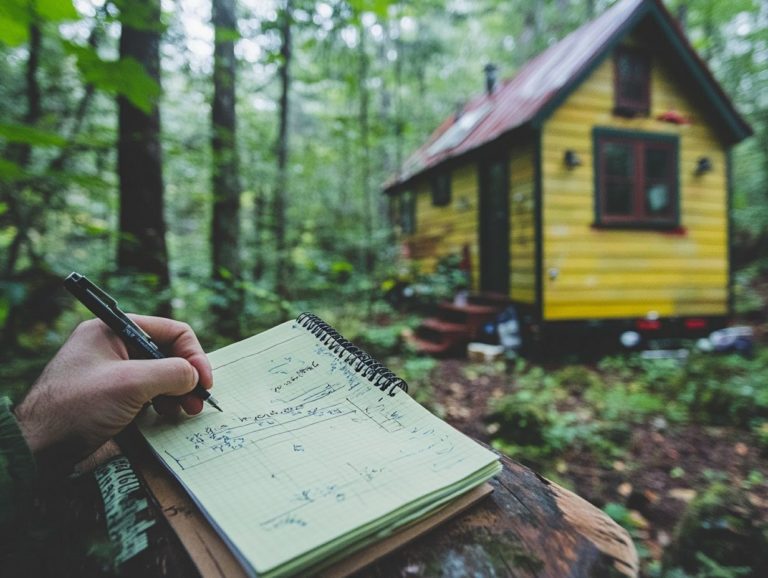Tiny House Living and Land Use: Legal Aspects
Tiny house living has captivated countless individuals yearning for a simpler, more sustainable lifestyle. The allure of downsizing is undeniable, yet navigating the legal landscape surrounding tiny homes can feel overwhelming.
This article delves into what precisely defines a tiny house, alongside the benefits and challenges that come with this lifestyle. It also covers the legal considerations you must be aware of.
From zoning laws that control how land can be used to land use options, this guide offers essential insights to empower you in making informed decisions on your tiny house journey.
Contents [hide]
- Key Takeaways:
- Understanding Tiny House Living
- Legal Considerations for Tiny House Living
- Land Use Options for Tiny Houses
- Navigating Legal Challenges
- Frequently Asked Questions
- What is a tiny house and why is it becoming popular in terms of land use and legal aspects, especially in cities like Los Angeles and San Diego?
- Do I need a special permit or approval to live in a tiny house?
- Can I legally park my tiny house on any piece of land?
- Are there restrictions on the size and design of a tiny house?
- Can I use a tiny house as a permanent residence in any state or city?
- What are the potential legal challenges of owning and living in a tiny house?
Key Takeaways:

- Tiny house living offers a unique and affordable way to live, but it’s important to understand the benefits and challenges before making the decision to downsize.
- Legal considerations, such as zoning laws, building codes, and necessary building permits, are crucial for successfully living in a tiny house and avoiding legal challenges.
- Buying land for a tiny house is a popular option, but alternative land use options such as renting, leasing, or joining a tiny house community can also provide a legal and cost-effective solution.
Understanding Tiny House Living
Understanding tiny house living invites you to explore a unique lifestyle choice that many pursue. This movement has captivated many across California, including cities like Fresno, San Diego, Sacramento, San Francisco, Los Angeles, Santa Cruz, and Isleton.
As individuals and families seek to downsize, they find themselves embracing a commitment to sustainable living in chic, compact homes. This movement showcases the myriad benefits of tiny homes, from a smaller environmental footprint to lower costs.
Living in tiny homes fosters a strong sense of community support and engagement. It’s an appealing option for those in search of affordable housing solutions, particularly in bustling areas like San Francisco and Fresno.
What is a Tiny House?
A tiny house is a compact living space typically measuring less than 400 square feet. These homes are carefully designed to make the best use of space while minimizing environmental impact.
In these unique living quarters, you’ll find an open-concept layout that cleverly combines multiple functions into a single area, providing both versatility and comfort. With their small footprint, many tiny houses feature lofted sleeping areas and foldable furniture, optimizing every inch of space.
Common eco-friendly construction materials include reclaimed wood, steel, and eco-friendly insulation. These materials not only enhance the aesthetics but also boost energy efficiency.
The focus on simplicity and style allows a tiny house to blend effortlessly into various landscapes. This appeals to those who cherish minimalism and eco-conscious living.
Benefits and Challenges of Tiny House Living
Living in tiny homes offers a wealth of benefits, including affordability and a reduced environmental footprint. The allure of embracing a mortgage-free lifestyle is also a major draw.
Yet, it comes with its own set of challenges, such as navigating zoning regulations and adapting to limited living space. For those who embrace this minimalist lifestyle, understanding tiny house occupancy permits can be crucial. One standout advantage is the significant drop in living costs.
This financial freedom allows you to direct your resources toward enriching experiences and building savings rather than being weighed down by hefty monthly bills. Tiny homes naturally encourage sustainable living, often utilizing eco-friendly materials and energy-efficient appliances. To understand the legal aspects better, check out tiny house living: legal myths debunked.
These aspects align beautifully with the growing sustainability movement, allowing you to contribute positively to the planet. Tight-knit communities often form around tiny house enclaves, providing invaluable support networks that foster meaningful relationships and shared resources.
However, it’s crucial to navigate the complexities of local regulations that dictate where these homes can be placed. Staying informed and proactive is essential for a liberating tiny house experience.
Legal Considerations for Tiny House Living

When you think about tiny house living, understanding the legal requirements is key. Focus on zoning regulations and building codes, as they vary across California cities like San Francisco, Fresno, and Isleton. These factors can greatly influence your tiny home project.
Zoning Laws and Building Codes
Zoning laws and building codes shape where you can build your tiny house. Familiarize yourself with local municipal codes to ensure compliance.
These regulations dictate the size and placement of your home and what activities are allowed on your land. Some California cities embrace tiny living with flexible zoning, while others impose strict measures that could limit your options.
Building codes require you to follow specific safety and structural standards, which will affect your design choices and materials. Local planning departments, like those in Los Angeles or San Diego, have unique stipulations that you must navigate to align your vision with community regulations, especially considering the tiny house movement and legal challenges.
Permits and Regulations
Securing your building permits is not just a step it’s crucial! Delays can set back your dream of tiny house living. Understanding the permitting landscape involves several key steps, starting with research into local zoning laws, which dictate where your tiny home can be situated.
You’ll often need to prepare and submit detailed building plans to local authorities, who will meticulously review them for compliance. Once you obtain approvals, expect to schedule inspections at various stages of construction, focusing on aspects like structural integrity, plumbing, and electrical systems.
Keep in mind that failing to secure proper permits can lead to fines or required modifications. This highlights the importance of thorough preparation and compliance throughout your building journey.
Land Use Options for Tiny Houses
When exploring land use options for tiny houses, consider purchasing residential lots or joining established welcoming tiny house communities. It’s essential to navigate local zoning regulations that impact land availability and usage to ensure your plans align with legal requirements.
Buying Land for a Tiny House

When considering the purchase of land for a tiny house, carefully navigate zoning regulations, property lines, setback requirements, and local planning and zoning ordinances to ensure your vision aligns with legal requirements.
Investigate whether your desired location permits such structures, as certain areas may impose restrictions that could hinder the installation of your tiny home. For a comprehensive overview, refer to tiny house regulations: a state-by-state guide. Understanding setbacks, minimum square footage requirements, and the management of utilities is crucial in your decision-making process.
Review the parcel’s topography and access to essential services such as water, sewage, and electrical hookups. This will aid in assessing the land’s viability and contribute to creating a more sustainable living environment. Additionally, understanding tiny house land use laws and conducting thorough due diligence on any covenants or easements will help you avoid potential complications down the road.
Alternative Land Use Options
Alternative land use options for tiny homes present a variety of choices, including tiny house communities, accessory dwelling units (ADUs), and campgrounds. Each option has its own benefits and challenges shaped by local regulations.
Navigating these options can profoundly impact your tiny house experience. Tiny house communities often cultivate a sense of belonging and provide shared resources, creating a supportive atmosphere. However, they may require adherence to specific community rules.
ADUs offer the allure of privacy and autonomy while also boosting property value. However, they might entail higher upfront renovation costs and zoning complexities.
Considering campgrounds for temporary housing presents a flexible and affordable solution, perfect for those who thrive on a nomadic lifestyle. However, they may lack the stability and essential services that long-term living often requires. Each option deserves thoughtful consideration to ensure it aligns with your individual goals and circumstances.
Navigating Legal Challenges
Dealing with the legal challenges of tiny house living demands a keen understanding of zoning laws and building codes, along with the potential necessity for legal counsel. This knowledge is essential to ensure code compliance while preserving the character of your neighborhood.
Common Legal Issues and How to Address Them
Common legal issues surrounding tiny house living often stem from zoning laws, permits, and building codes. It s essential to seek legal advice from experts to navigate these complexities with confidence.
You may find the legal landscape particularly challenging, as local governments often have differing interpretations of what qualifies as a dwellings. This can lead to disputes. You might encounter restrictive zoning laws that dictate where tiny homes can be situated or stringent building codes that require adherence to traditional housing standards. Understanding the importance of zoning in tiny house living can help navigate these complexities.
Obtaining the necessary permits can feel overwhelming, especially if your home is mobile. To tackle these challenges, it’s wise to connect with local advocacy groups or legal experts who specialize in understanding tiny house zoning laws. This way, you can ensure compliance and enjoy a smoother transition into this unconventional lifestyle.
Frequently Asked Questions

What is a tiny house and why is it becoming popular in terms of land use and legal aspects, especially in cities like Los Angeles and San Diego?
A tiny house is a small, often mobile, living space that typically ranges from 100 to 600 square feet. It is becoming popular due to its affordability, minimalist lifestyle, and eco-friendliness. In terms of land use and legal aspects, it has sparked debate due to its unconventional nature and questions surrounding zoning and building codes.
Do I need a special permit or approval to live in a tiny house?
The answer depends on several factors, such as the location of your tiny house and whether it is considered a permanent or temporary residence. In most cases, if it is being used as a permanent residence, you will need to obtain the necessary permits and approvals from local authorities. It is important to research and understand the specific laws and regulations in your area.
Can I legally park my tiny house on any piece of land?
No, you cannot park your tiny house on any piece of land without permission. Most areas have zoning laws that dictate where certain types of structures can be placed. If you plan to park your tiny house on private property, you will need to obtain permission from the property owner and ensure that it complies with local zoning regulations.
Are there restrictions on the size and design of a tiny house?
Yes, there are often restrictions on the size and design of a tiny house. Local building codes and zoning laws typically have minimum square footage requirements for dwellings and specific regulations for the construction and design of homes. Some areas may also have restrictions on the use of certain materials or the presence of utilities.
Can I use a tiny house as a permanent residence in any state or city?
No, not all states or cities allow tiny houses as permanent residences. It’s crucial to research the specific laws and regulations where you plan to live.
Some cities have strict building codes and zoning rules against tiny houses. Others may have more lenient regulations, making it easier for you to settle in.
What are the potential legal challenges of owning and living in a tiny house?
Owning a tiny house can come with legal hurdles. You may need to obtain permits, follow building codes, and ensure your structure is safe and livable.
If you want to park your tiny house on someone else’s property, you’ll need to consider land use agreements and liability issues.






